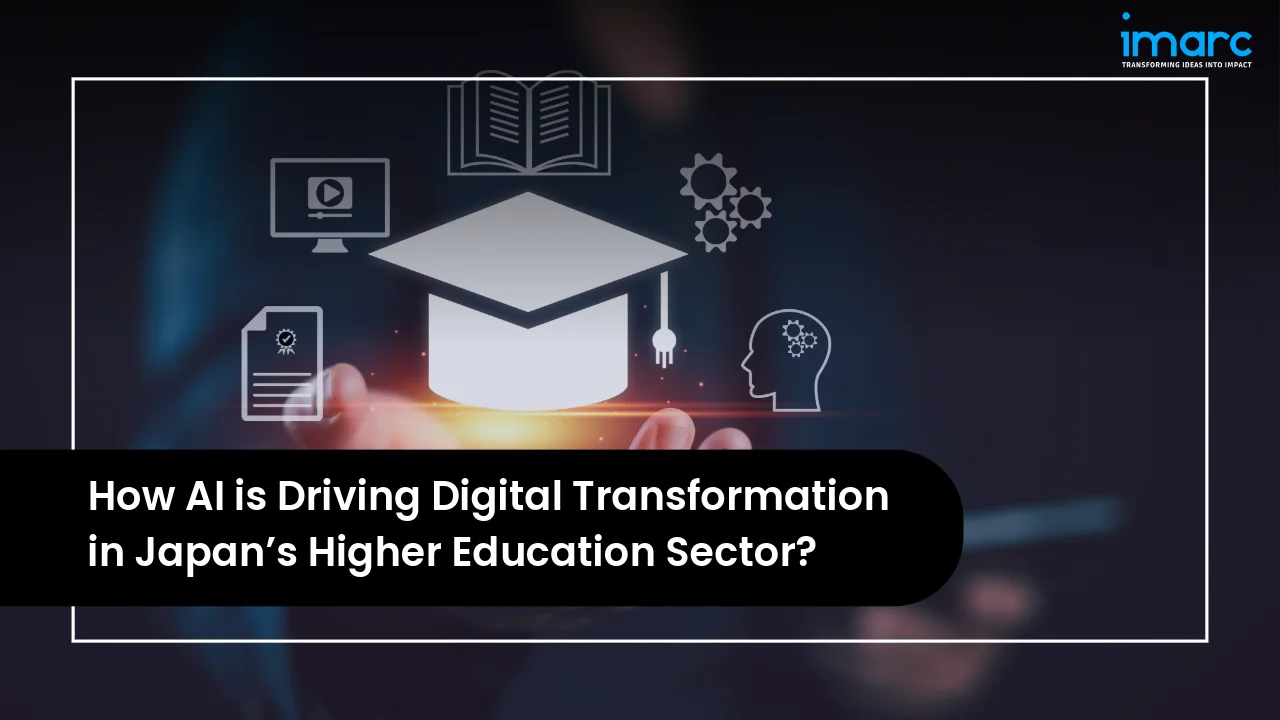How AI is Driving Digital Transformation in Japan’s Higher Education Sector?

Japan’s higher education sector is at a major turning point as demographic and economic pressures converge with technological disruption. One of the major trends in the Japan higher education market include the number of students entering universities has been shrinking for decades due to the country’s aging population, creating structural challenges for institutions that once relied on a stable or growing pool of applicants. As of January 1, 2025, the population of those who turned 18 (the age of legal majority in Japan since 2022) was 1.09 million. This figure is up by 30,000 from the previous year, but it remains the second lowest ever recorded. At the same time, Japan’s universities are under pressure to maintain international competitiveness in research output, digital adoption, and global rankings. International student enrollment has been growing modestly, a new record with 336,708 international students enrolled as of May 1, 2024, a 20.6%–21% increase from the previous year. Within this climate, AI and digital education technologies are being recognized as key enablers of modernization. They allow institutions to compensate for declining numbers, enhance efficiency, and expand their reach in global higher education markets.
The pressures faced by Japanese universities include administrative inefficiencies, student disengagement, faculty shortages in specialized areas, and rising demands for accountability in outcomes. Traditional reliance on paper-based processes slows down everything from admissions to grading, while students expect personalized, digital-first experiences. AI and digital platforms are being adopted to provide intelligent scheduling, adaptive learning, and predictive analytics for addressing challenges through digital solutions, which collectively optimize resources and improve student success. In October 2024, Japan’s Ministry of Education, Culture, Sports, Science and Technology (MEXT) requested a FY2025 budget of 5,953 billion yen (USD 39.9 billion), an 11.5% increase from the previous year, including 1,182 Billion Yen for science and technology and 139.6 Billion Yen for energy measures.
AI Technologies Revolutionizing Japan’s Universities:
Personalized Learning and the Japan Digital Education Market
Artificial intelligence is reshaping the way education is delivered in Japanese universities by enabling highly personalized learning experiences. Traditionally, classes were standardized and focused on uniform delivery, with limited room for tailoring instruction to individual needs. AI has changed this dynamic, as platforms now analyze student performance, engagement levels, and learning pace to recommend targeted study materials. In November 2025, NTT West and Ritsumeikan University announced a joint initiative to integrate generative AI into education, supporting both personalized learning and collaborative learning across the Ritsumeikan Academy’s community. The program will cover approximately 50,000 current students and 400,000 alumni, all connected via LinkU-ID, and will utilize AI in combination with e-textbooks and LMS platforms to create competency-based, individually optimized learning systems.
This development, aligned with Japan’s “Academy Vision R2030,” reflects the growing role of AI technologies in the country’s digital education market, signaling significant momentum in personalized education solutions. Beyond language courses, personalized platforms are being applied to STEM fields, offering real-time feedback on problem-solving and coding tasks. The Japan Digital Education Market has seen increased investment from EdTech startups like Atama Plus, which provides AI-driven adaptive learning software for mathematics and science, used by universities and high schools nationwide. These tools maintain student engagement in a shrinking domestic market and support Japan’s broader objective of developing globally competitive graduates prepared for a digital workforce.
Administrative Automation and Efficiency Gains
Administrative workloads in Japanese universities remain a major bottleneck, with faculty and staff spending considerable time on admissions, recordkeeping, and course management. AI systems are being introduced to automate repetitive tasks, significantly reducing time and cost burdens while improving accuracy. Keio University implemented an AI-based admissions screening tool in April 2025, cutting essay evaluation times and reducing human bias by leveraging natural language processing. Universities are also using predictive analytics to forecast enrollment trends, optimize classroom utilization, and better allocate teaching staff across programs.
AI chatbots, deployed at institutions such as Meiji University, handle thousands of student inquiries daily, freeing administrative staff to focus on higher-value tasks. Automated grading tools are being applied to large-scale online exams, ensuring faster turnaround and fairer evaluation. The broader efficiency gains align with Japan’s societal push toward digital transformation under the Society 5.0 initiative, which envisions AI as a foundational technology for streamlining systems and enhancing productivity. For universities, these upgrades are not just cost-saving measures but vital tools for maintaining quality education amid shrinking resources.
Enhancing Student Experience through AI:
Improving student engagement and learning outcomes is central to Japan’s higher education reforms, and AI-powered adaptive platforms are emerging as indispensable tools. Adaptive learning platforms in the Japan digital education market track student progress in real time, identifying knowledge gaps and recommending targeted content or exercises to address weaknesses. Waseda University has a notable AI innovation program called "Waseda University Innovation Ecosystem Program for Next-Generation AI Pioneering Research (W-SPRING-AI)" launched in 2024 to foster AI research and advanced capabilities among doctoral students. The result has been improved course completion rates and higher levels of satisfaction. Also, in August 2025, Japan’s Ministry of Education announced plans to incorporate generative AI and digital tools into Japanese language education for children with foreign roots, addressing the needs of roughly 69,000 students requiring language support. About 10% of these students currently lack classroom or after-school assistance, prompting the government to introduce AI-powered translation apps and online teaching systems as part of its fiscal 2026 budget.
The initiative reflects Japan’s push to expand personalized digital education and AI-driven inclusion, strengthening the role of the country’s digital education market in supporting diverse student populations The impact extends beyond academics, as adaptive learning reduces stress and builds confidence, which are critical factors in maintaining retention in a shrinking student population. As the labor market in Japan undergoes rapid technological change, career counseling has become a key area where AI tools provide value. Japan has designated 52 pilot schools for trials using generative AI in classrooms, including for Japanese language teaching.
Traditional career centers rely heavily on manual processes, often overwhelmed by large volumes of students seeking guidance. AI platforms now analyze academic records, skills, extracurricular activities, and labor market data to recommend career paths, internships, and job placements. Virtual assistants powered by natural language processing are being used to answer student questions on interview preparation, resume drafting, and professional etiquette around the clock. These platforms also extend into mental health support, offering AI-based chat counselors to detect stress signals and suggest interventions. As Japanese employers shift toward skill-based recruitment, AI-driven career counseling and support services ensure that graduates are not only academically qualified but also workforce-ready.
AI and Robotics in Education:
Japan is a global leader in robotics innovation, and its educational sector reflects this advantage. Robots are being used for language learning, interactive tutoring, and research collaborations, blending digital learning with hands-on engagement. The government’s Society 5.0 framework emphasizes robotics as a key driver of national competitiveness, with subsidies encouraging universities to experiment with AI-robotics integration, thereby promoting the growth of the Japan educational robot market. In May 2025, Arm and SoftBank Group announced a USD 15.5 Million contribution to Carnegie Mellon University to support its AI research partnership with Keio University in Japan. This funding is part of a broader U.S.–Japan AI collaboration launched a year earlier, backed by USD 110 Million in commitments from global and Japanese companies, with research spanning multimodal and multilingual learning, embodied AI for robotics, AI-human symbiosis, and AI for scientific discovery. Demand for engineering and robotics programs has also increased, as students see the technology as critical to Japan’s industrial future. With global competition in robotics intensifying, Japan’s educational institutions are using robots not just as teaching tools but also as platforms for student-led innovation. This dual role cements robotics as both an instructional aid and a strategic industry-training mechanism.
The deployment of interactive robots is transforming classroom environments by introducing interactive robots enhancing classroom engagement that traditional methods struggle to achieve. Pepper, SoftBank’s humanoid robot, has been used in Kyushu University to conduct conversational practice in English classes, providing students with a tireless partner for dialogue and pronunciation exercises. Robots are also assisting students with disabilities, offering translation, mobility guidance, and real-time note-taking capabilities. These tools are particularly valuable in large classrooms, where individual attention is often limited. Additionally, robots are being integrated into hybrid teaching environments, assisting with livestream management and remote participation. Feedback from pilot projects indicates that interactive robots reduce student anxiety in language learning and foster stronger participation among previously disengaged learners. Ericsson Japan, SoftBank, and the Fukuoka SoftBank Hawks will launch the “HERO Lab” robotics education program in September 2025, at the Oh Sadaharu Baseball Museum in Fukuoka, inviting students from fifth grade through first year of junior high to engage in hands-on robot assembly and programming via a baseball-themed competition, with mentors from Ericsson and SoftBank. As universities continue to expand international programs, robots capable of multilingual support are expected to become widespread. Their use signals a new era in education where human instructors and AI-powered robots collaborate to maximize classroom engagement and inclusivity.
Overcoming Challenges in AI Adoption:
- Data Privacy and Ethical Issues in Japan’s Digital Education Market
AI adoption in Japanese universities is tempered by ongoing concerns about student data security, algorithmic transparency, and responsible governance. The Act on the Protection of Personal Information (APPI) sets strict rules on how institutions collect, store, and use data, requiring universities to enhance compliance frameworks as they roll out AI systems. Ethical debates have intensified around automated grading, student monitoring, and predictive analytics, with stakeholders warning about bias and lack of accountability. Several universities, including Keio and Kyoto, have published AI usage policies clarifying how generative AI can and cannot be used in admissions, coursework, and research. MEXT has also signaled that it will expand digital ethics training to ensure universities adopt AI responsibly. These measures are intended to balance innovation with safeguards, ensuring that AI strengthens learning outcomes without compromising rights, privacy, or academic integrity across higher education.
- Faculty Training and Infrastructure Upgrades
Successful AI deployment depends on both digital infrastructure and faculty readiness. Many universities lack the broadband capacity, computing resources, or software ecosystems required to integrate advanced AI tools effectively. Faculty, meanwhile, often express hesitancy about adopting unfamiliar technologies or fear displacement by automation. Simultaneously, universities are investing in digital literacy programs, equipping professors with training in AI tools and faculty digital transformation hubs providing workshops and certification for academic staff, for grading, course customization, and student support. These initiatives signal that the adoption challenge is not just technical but cultural. Building confidence among educators is essential to unlocking AI’s full potential in Japan’s higher education sector.
Case Studies: Japanese Universities Leading AI Integration
Several universities in Japan are already demonstrating the tangible benefits of AI integration, creating success stories in the Japan higher education market. By embedding AI across teaching, administration, and research, these universities provide models that others across Japan are now studying and replicating. Industry partnerships are proving central to Japan’s higher education digital transformation.
- In May 2025, JST and the UK’s EPSRC closed the ASPIRE 2025 call, funding up to four Japan-UK projects on human-centered AI, robotics, health, and interfaces. Each project will receive up to JPY 280 Million (USD 2 Million) from JST and GBP 1.5 Million (USD 1.9 Million) from EPSRC, running from January 2026 to March 2031.
- In November 2024, Accenture and Kyoto University signed a comprehensive collaboration agreement to advance research and innovation in human-centered AI, combining expertise from behavioral economics, psychology, and philosophy with applied AI development. The partnership will leverage the new Accenture Center for Advanced AI Kyoto to pursue joint research on responsible AI, multi-agent large language models, and AI for organizational performance, while also training future AI leaders.
- In April 2024, the U.S. and Japan launched two AI research partnerships, University of Washington with University of Tsukuba, and Carnegie Mellon with Keio, backed by USD 110 Million from global tech firms. The projects focus on workforce development, multimodal AI, robotics, human–AI symbiosis, and life sciences, reinforcing bilateral science and technology cooperation.
- In July 2023, Japan committed JPY 300 Billion (USD 2.12 Billion) to 111 universities over 10 years to expand digital and green technology programs and address a projected shortfall of 800,000 IT experts by 2030. Around 30% of funded institutions are humanities universities creating STEM departments, highlighting AI-driven curricula and industry partnerships in Japan’s higher education transformation.
These collaborations with AI and robotics firms provide dual benefits: universities gain cutting-edge technologies and funding, while companies secure testing grounds for products and future talent pipelines. They also reflect the growing diversity of AI use cases, from academic support to large-scale operational improvements. The outcomes also highlight the scalability of AI when supported by institutional leadership. Japan’s government actively encourages these public-private partnerships as part of its Society 5.0 vision, recognizing that integration between academia and industry is essential. Together, these initiatives accelerate AI adoption while aligning higher education more closely with labor market and national innovation priorities.
Future Outlook: AI’s Role in Japan’s Digital Education Evolution:
Emerging trends in the Japan digital education market include the rollout of 5G, IoT, and cloud infrastructure. Universities are moving toward hybrid ecosystems that combine physical classrooms with digital platforms powered by AI analytics. Demand for micro-credentials and modular programs is rising, driven by working professionals seeking reskilling opportunities in data science, AI, and advanced technologies. This trend is reshaping curricula, as universities adopt flexible, AI-enabled programs tailored to industry needs. In June 2025, the University of Osaka’s Diversity and Community Engagement Research Center and Fujitsu Japan launched a four-month joint research project to develop a generative AI model that creates individualized education plans for culturally and linguistically diverse (CLD) children. The project builds on MEXT’s new Matrix of Language Development and Acquisition for CLD Students and involves validating AI-generated plans in collaboration with Osaka Prefecture, addressing the needs of over 130,000 CLD students in Japan’s public schools.
AI tools will also expand into research management, assisting with grant allocation, publication analysis, and collaboration matching. The overall trajectory points to universities functioning as digitally intelligent ecosystems where AI serves not only as a teaching tool but also as a driver of institutional strategy, efficiency, and international competitiveness. Japanese universities are also focused on preparing students for the AI-Driven future. AI literacy courses are being embedded into general education requirements, ensuring all students, regardless of discipline, gain exposure to machine learning, data science, and digital ethics. Universities like Tohoku and Waseda have already launched cross-disciplinary programs that combine humanities with AI training, recognizing that tomorrow’s workforce needs both technical skills and humanistic perspectives.
Employers in Japan are increasingly emphasizing skill-based hiring, with AI engineers earning 40% more than the national average salary of 4.41 Million Yen, and top-tier companies offering packages as high as 1.25 Million Yen per month (20 Million Yen annually). To align with these trends, universities are building partnerships with industry to offer internships, project-based learning, and AI-focused research labs. Beyond employability, the integration of AI into education reflects Japan’s Society 5.0 strategy, which envisions a “super-smart society.” By equipping students with AI-related competencies, universities ensure they can contribute meaningfully to innovation, competitiveness, and social progress in an era defined by technology.
Empowering Japan’s Higher Education Transformation: IMARC’s Strategic Intelligence for the AI-Driven Academic Market
As Japan’s higher education sector embraces digital transformation, artificial intelligence is emerging as a decisive force shaping pedagogy, administration, and global competitiveness. IMARC Group equips universities, EdTech firms, policymakers, and investors with the research intelligence required to navigate this transition and unlock sustainable growth opportunities.
How IMARC Supports Higher Education Stakeholders:
- AI Adoption Mapping: Tracks integration of adaptive learning platforms, predictive analytics, and robotics across Japanese universities.
- Policy and Funding Landscape: Analyzes MEXT initiatives, digital campus subsidies, and Society 5.0 programs driving AI adoption in academia.
- EdTech and Vendor Intelligence: Profiles leading domestic and global AI education technology providers, partnerships with universities, and competitive differentiation strategies.
- Infrastructure and Faculty Readiness Assessment: Evaluates progress in cloud adoption, cybersecurity, digital literacy programs, and training models for academic staff.
- Investment and Collaboration Insights: Identifies funding trends, startup–university partnerships, and public–private AI research collaborations.
- Forecasting and Strategic Planning: Offers granular projections by technology type, application area, and institution size, guiding universities and investors toward data-driven, future-ready strategies.
Our Clients
Contact Us
Have a question or need assistance?
Please complete the form with your inquiry or reach out to us at
Phone Number
+91-120-433-0800+1-201-971-6302
+44-753-714-6104
.webp)










